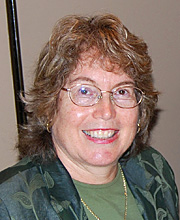As Jews, “we tend to focus on the “˜oy vey’ moments,” in our history, author Maggie Anton told the Seattle Chapter of Hadassah’s annual kick-off brunch in September. But the author of the successful Rashi’s Daughters trilogy focuses on a relatively safe and prosperous time for Jews in her novels. Anton spoke with JTNews about that period, about writing and selling books, and about why women should study Talmud.
Rashi, Rabbi Solomon ben Isaac, was an 11th-century French Torah and Talmud commentator whose writings are universally studied today.
Anton was intrigued by evidence that Rashi, who had no sons, taught his daughters Torah and Talmud, and that became the initial seed for the books. She always intended to write a trilogy, and outlined all three books from the start. Two have been published so far and Anton is currently completing the third.
Set in Rashi’s home of Troyes, France, at a time of relative harmony between Jews and their neighbors, Anton renders daily activities in great detail, including study sessions between Rashi and his daughters. “As I came across an interesting item [of Talmud] in my own studies, I would try to include it in the books,” says Anton, who has become an informal expert on medieval French life, as well as Talmud, as a result of her research.
The first of Anton’s historical fiction trilogy, Joheved, was published in 2005 in honor, Anton explains, “of Rashi’s 900th yahrzeit [anniversary of his death], and I had that self-imposed deadline.”
However, “in 2004, my agent had not yet found a buyer, so I said, “˜thanks, but no thanks,’ and looked into publishing it myself.”
She and her husband David formed Banot Press and issued the first book with the help of a professional editor and marketing consultant.
After Joheved sold 20,000 copies in two years, major publishing houses took notice, and there was “a bidding war for the series.” Book Two: Miriam, released in August by Plume, was published early thanks to requests by Barnes & Noble and Borders to have the book ready for their High Holiday tables — though not in this market.
“The reason I went with Plume rather than self-publishing again was not for money, but for a new level of marketing,” says the author.
Anton’s initial success was completely her own doing.
“I knew who my audience was going to be — Jewish women,” the life member of Hadassah says, “so I joined every Jewish women’s organization there ever was: ORT, NCJW, temple sisterhoods, all of them looking for people to talk to them. I was willing to talk for free and hawk my books.”
As a first-time author, Anton admits she was naïve about the demands of marketing. “If I had known in advance what it entailed, I would have thought I couldn’t do it,” she says.
Anton worked as a chemist for 30 years and had never planned to be a novelist.
“I didn’t pick up a crayon in preschool and declare I wanted to be a writer,” she says.
The native Californian and mother of two grown children was initially inspired by a Talmud class at her synagogue, taught by Rabbi Aaron J. Katz, who received his smicha (ordination) from the chief rabbi of Israel. “I asked him to help me translate some Rashi and he said, “˜fine.’” Katz and Anton still meet weekly.
While finishing Book Three: Rachel, Anton has also been translating the Machzor Vitry, a collection of legal writings and liturgy collected by Rashi’s students. It wasn’t published until the 1800s and is not indexed or organized, but it offers excellent details about everyday life.
From the sections on women, Anton observes, “it’s clear that women were doing a lot more liberal stuff” in the Middle Ages than we would assume. The book contains a complete Passover Seder, but minus the Four Sons. “Kosher rules were different,” as well, “because people didn’t cook with cheese,” and families rarely owned a second set of dishes or extra plates for Passover.
Even with success, Anton is still “astonished” to get fan mail. For the second book, “I’m getting more reaction from the Orthodox community about Miriam being a mohelet [ritual circumciser] than about the yeshiva bochers [students] falling in love,” she says of one of book’s plot components.
“I didn’t show anyone in Rashi’s family breaking halachah, but that meant I had to find out what was considered halachah at the time. For example, they ate wild birds. And many women didn’t go to the mikvah, they went to the hot baths in town. We know this because the rabbis complained about it all the time.”
Anton wrote Rashi’s Daughters “to bring more women to Talmud. As we create a critical mass of educated Jewish women, we will be able to take our place at the table where Jewish law is interpreted. Now the only people sitting at that table are men.”
And “liberal Jews should know the Talmud,” she advises, “because it’s where the reforms started.”
Anton calls Sidney Taylor’s children’s book series, All—of-a-Kind Family — a big influence. “I wanted to do an All-of-a-Kind-type series about Rashi’s daughters, but for adults, so there could be sex. I also insisted there be Talmud in it.” However, for women who have clamored for a book that they can give to their young daughters, a young-adult version of Joheved will be published by JPS in 2008.
Writing what she knows
